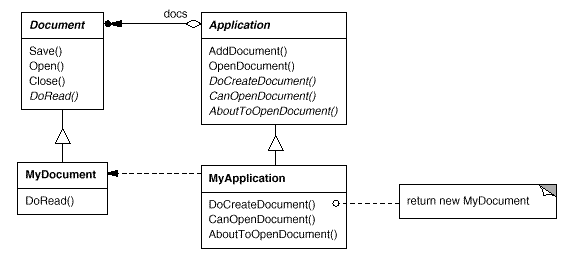Applied Design Patterns with Java
Behavioral :: Template Method (325) {C ch 25}
Intent
Define the skeleton of an algorithm in an operation, deferring
some steps to subclasses. Template Method lets subclasses redefine certain steps of an algorithm without changing the algorithm's
structure.
Motivation
Consider an application framework that provides
Application and Document classes. The Application class is responsible for opening existing documents stored in
an external format, such as a file. A Document object represents the information in a document once it's read from
the file. Applications built with the framework can subclass Application and Document to suit specific needs.
For example, a drawing application defines DrawApplication and DrawDocument subclasses; a spreadsheet application
defines SpreadsheetApplication and SpreadsheetDocument subclasses.

The abstract Application class defines the algorithm for opening and reading a document in
its OpenDocument()
operation, and it also defines each step for opening a document. It checks if the document can be opened, creates
the application-specific Document object, adds it to its set of documents, and reads the Document from a file.
OpenDocument()
is a Template Method, and it defines an algorithm in terms of abstract operations that subclasses override
to provide concrete behavior. Application subclasses define the steps of the algorithm that check if the document
can be opened (CanOpenDocument) and that create the Document (DoCreateDocument). Document classes define the step
that reads the document (DoRead). The Template
Method also defines an operation that lets Application subclasses
know when the document is about to be opened (AboutToOpenDocument), in case they care.
By defining some of the steps of an algorithm using abstract operations, the Template Method fixes their ordering,
but it lets Application and Document subclasses vary those steps to suit their needs.
Catalog Behavioral
Prev Next
